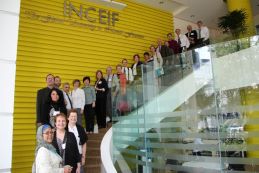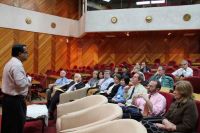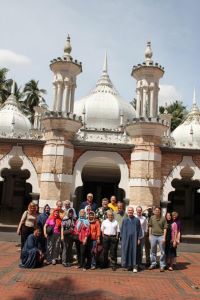Malaysia is a predominantly Muslim country, a fact brought home today at our three stops–two business visits and the newly-built capital at Putrajaya.
The first visit was to a University that specializes in Islamic finance,  recently empowered to award Ph.D.s in the subject. The Qur’an forbids interest, which gives finance a different spin here. Malaysia was one of the first countries to stress Islamic finance, and it seems to me that the topic is part of Malaysia’s efforts to become more than a small tiger. Near as I can figure, Islamic finance means a more cooperative buyer-bank relationship, more akin to what happens in joint ventures.
recently empowered to award Ph.D.s in the subject. The Qur’an forbids interest, which gives finance a different spin here. Malaysia was one of the first countries to stress Islamic finance, and it seems to me that the topic is part of Malaysia’s efforts to become more than a small tiger. Near as I can figure, Islamic finance means a more cooperative buyer-bank relationship, more akin to what happens in joint ventures.
The second visit was to the University of Putra Malaysia, the largest university in the country. We were hosted by the Graduate School of Management, which has nearly 1,000 students. The university originated as an agricultural school, and its sprawling campus can certainly accommodate many farms. I think I saw a palm tree plantation on the campus. The talk dealt with halal food, which is food that conforms to  shariah law (the Muslim standard; Islamic banks do have a board which determines whether or not new products meet the shariah codes, with the final say held by the Central Bank’s shariah board). The standards determine the process for goods not banned by the Qur’an (alcohol is banned; the joke is that halal beer is served at A&W). The University conducts research on the topic (halal applies to non-food items as well), but the food industry is one which Malaysia is trying to capture for the Muslim world. The government has issued a major volume which lists the standards for halal. One thing I briefly glimpsed on our tour was a billboard listing the “prohibited behaviors.” One was kissing; another handholding. No PDAs here.
shariah law (the Muslim standard; Islamic banks do have a board which determines whether or not new products meet the shariah codes, with the final say held by the Central Bank’s shariah board). The standards determine the process for goods not banned by the Qur’an (alcohol is banned; the joke is that halal beer is served at A&W). The University conducts research on the topic (halal applies to non-food items as well), but the food industry is one which Malaysia is trying to capture for the Muslim world. The government has issued a major volume which lists the standards for halal. One thing I briefly glimpsed on our tour was a billboard listing the “prohibited behaviors.” One was kissing; another handholding. No PDAs here.
The third visit was to Putrajaya, the capital built in the 1990s (I want to say  1996 or so, about the same time as the Petronas Towers). The government moved all its offices about 40 miles from KL, and built apartment complexes to house government employees. It sold the downtown properties it was evacuating in KL to build the new town, so the guide assured us no government funds were involved in the massive transfer of people and processes. The first building was an enormous sand colored reddish mosque, built on the shores of a man-made lake, and that pretty much sets the tone of the city. It is truly monumental, rather on the scale of Chang’an avenue in Beijing. The difference with Beijing is that the buildings here are Muslim with domes, arches, and latticework. It is very impressive, indeed, and does seem to mark Malaysia’s coming of age. Muslim government employees get a 10 % discount, as part of the ruling UMNO (the Muslim party) effort to raise the standards of living of the Malays. Malays seem to dominate the political sphere, while Chinese dominate business. When I asked a Chinese professor at the University about Chinese representation at the University, her reply was a cryptic, “It’s very sensitive.” Malaysia officially does celebrate diversity.
1996 or so, about the same time as the Petronas Towers). The government moved all its offices about 40 miles from KL, and built apartment complexes to house government employees. It sold the downtown properties it was evacuating in KL to build the new town, so the guide assured us no government funds were involved in the massive transfer of people and processes. The first building was an enormous sand colored reddish mosque, built on the shores of a man-made lake, and that pretty much sets the tone of the city. It is truly monumental, rather on the scale of Chang’an avenue in Beijing. The difference with Beijing is that the buildings here are Muslim with domes, arches, and latticework. It is very impressive, indeed, and does seem to mark Malaysia’s coming of age. Muslim government employees get a 10 % discount, as part of the ruling UMNO (the Muslim party) effort to raise the standards of living of the Malays. Malays seem to dominate the political sphere, while Chinese dominate business. When I asked a Chinese professor at the University about Chinese representation at the University, her reply was a cryptic, “It’s very sensitive.” Malaysia officially does celebrate diversity.
 Compare the Putrajaya mosque above to its Indo-European counterpart in Kuala Lumpur.
Compare the Putrajaya mosque above to its Indo-European counterpart in Kuala Lumpur.
The restaurant we went to had a fish tank with a poster, one Malaysia, all fish, regardless of species, swim together in harmony. In the back of my mind, though, reflecting my reading on the end of the Ottoman Empire, I wondered whether the goal of Malaysia is to become the new Caliphate, albeit as the political/economic beacon of the Islamic world.